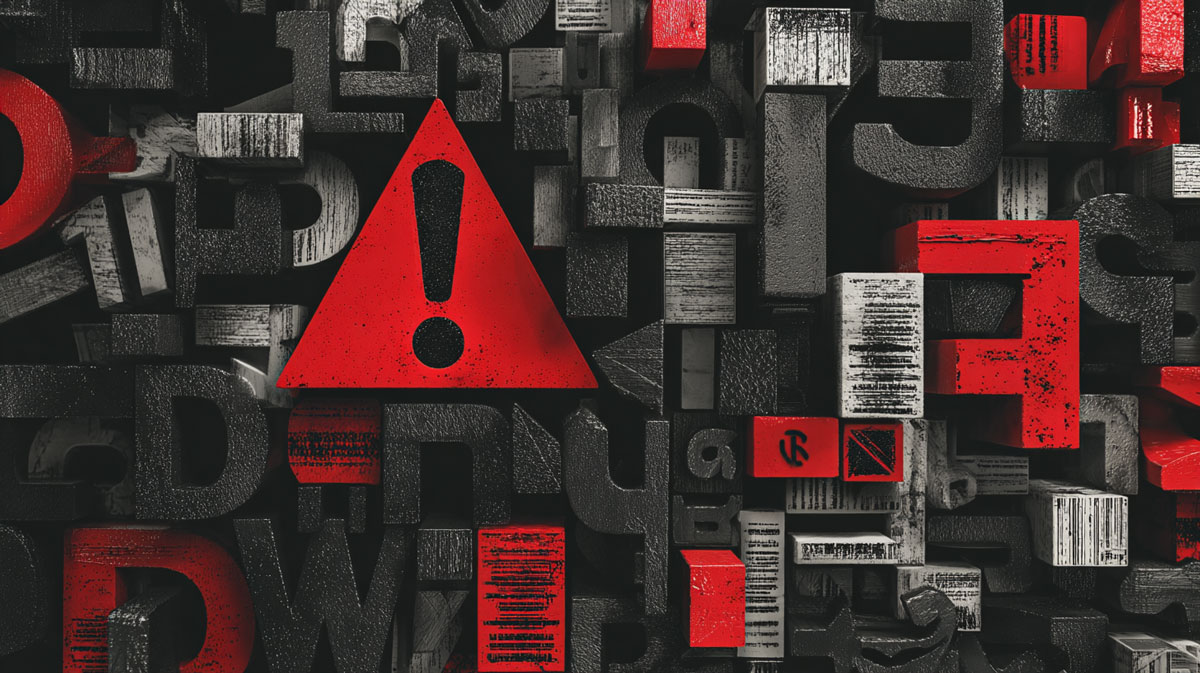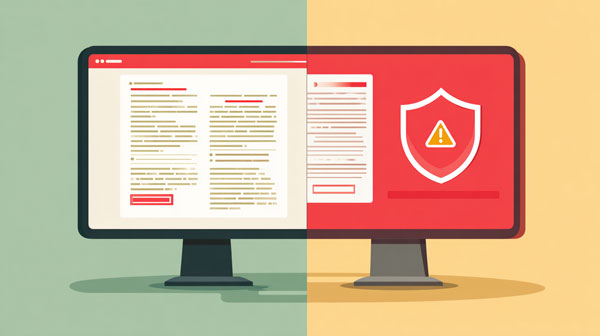
NBCUniversal didn't just get sued once for font licensing violations. They got sued three times in three years. Font Bureau sued them for $2 million in 2009. P22 Type Foundry sued for $1.5 million in 2011 over Harry Potter merchandise. Then Brand Design Co. sued for $3.5 million in 2012.
Each time, they had purchased fonts - but they used them in ways their licenses didn't cover.
Font licensing violations happen at every level, from global corporations to small agencies. The complexity of font licensing creates traps even for people trying to do the right thing - read about how licensing complexity catches careful users. The good news? Most mistakes are preventable once you understand the common patterns. Let's break down the mistakes that cost companies real money.
1. Buying Desktop, Using on Web
You buy a font, install it on your computer, design a website mockup, and push it live. Seems straightforward, right?
Wrong. Desktop licenses and web licenses are completely different things.
When you purchase a desktop license, you're buying permission to install that font on specific computers and use it to create static graphics - logos, PDFs, print materials, images. That's it. The moment you upload those font files to your web server and serve them to visitors via CSS, you've stepped outside your license. For a detailed explanation of how desktop and web font licenses differ, see our complete guide to desktop vs web font licenses.
Web font licenses work differently. They're typically priced based on monthly page views. Some foundries charge $40-100 per year for up to 10,000 monthly page views, scaling up from there.
In the NBCUniversal case, Oxygen Media had purchased a desktop license for Chalet, but the font appeared across NBC's websites, requiring a web font license they never obtained.
Check your licenses before any font touches your website code. If you're not sure whether you have web rights, assume you don't.
2. Exceeding License User Limits
Many desktop font licenses specify a maximum number of users or computers. A "5-user license" means exactly five people can have that font installed. Not five people at a time. Not roughly five. Exactly five.
Companies run into trouble when they grow from five designers to fifteen, don't track who has fonts installed, or let contractors install fonts temporarily without removing them.
Each unauthorized installation violates your license agreement. Font foundries sometimes use automated tools to detect when a company's usage suggests more widespread use than their license allows.
Keep a spreadsheet of who has which fonts installed. When someone leaves, remove fonts from their machine before reassigning the license. If you've outgrown your license, purchase additional seats - it's far cheaper than dealing with an infringement claim.
3. "Free for Personal Use" Means It's Not Free for Business
You find the perfect font on Dafont. It's free to download. You use it for a client's logo. This seems fine because you're not charging them for the font itself.
This is a licensing violation waiting to happen.
"Free for personal use" has a specific meaning: hobby projects, school assignments, personal blogs with no ads. The moment money is involved - client work, your business website, products you sell - it becomes commercial use.
Commercial licenses for these fonts typically cost $20-200. The violation cost can be much higher.
Copyright law allows statutory damages of $750 to $30,000 per work infringed, and up to $150,000 if the infringement is willful.
Before using any "free" font in business contexts, verify its license explicitly allows commercial use. Look for phrases like "commercial use allowed" or licenses such as SIL Open Font License. For help finding legitimate free fonts for commercial projects, see our complete guide to free fonts. When in doubt, pay for the commercial license or choose a different font.
4. Using Fonts Beyond License Scope
Font licenses often specify exactly where and how you can use a typeface. You buy a font for your logo, then start using that logo on t-shirts, mugs, and product packaging.
Depending on your license terms, this might be fine - or a serious violation.
P22 Type Foundry's lawsuit against Universal Studios over Harry Potter merchandise is a textbook example. Universal had a license for digital use but used the Cezanne font on physical products like pillows, caps, and stationery sets.
Similarly, HypeForType sued Universal Music Group for $1.25 million in 2017 when The Vamps' logo appeared on merchandise and promotional materials without proper commercial licensing. Logo use specifically requires careful attention to licensing terms.
Your EULA will specify what's covered: desktop use, web use, app embedding, e-book/PDF embedding, broadcast use, merchandise/product use. Each category typically requires separate rights or an upgraded license.
5. Sharing Fonts with Contractors or Clients
Your agency hires a freelance designer. You send them your brand fonts so they can work on the project. Seems like standard collaboration, right?
Most font licenses explicitly forbid this.
The typical EULA states that only licensed users can install and use the font. When you send fonts to contractors, you're redistributing software you don't have permission to redistribute. For a detailed look at who's actually liable when font licensing goes wrong, see our guide to agency font licensing liability.
The proper approach:
Have contractors purchase their own licenses for fonts they'll use regularly
Use your agency's licensed computers for all font-dependent work
Check if your license terms allow temporary contractor access (some do with restrictions)
For client projects, you can usually deliver finished designs as images or PDFs with embedded/outlined fonts. What you typically cannot do is hand your client the font files themselves. If clients need the actual font files to edit your work later, they need their own license.
6. Assuming Subscription Cancellation Won't Matter
Adobe Creative Cloud includes access to thousands of fonts through Adobe Fonts. You design a client's website using these fonts. Two years later, you cancel your subscription to save money.
That client's website now has a licensing problem.
Adobe's web font licensing specifically states that if you cancel your subscription, web fonts are no longer available and websites will display fallback fonts. Your commercial usage rights end when your subscription ends.
This catches agencies by surprise. They treat Adobe Fonts like permanent assets, but they're subscription-dependent. If you've used Adobe Fonts on client websites, either maintain your subscription indefinitely, have clients set up their own subscriptions, or migrate to properly licensed alternatives before canceling.
7. Converting Fonts to "Get Around" Licenses
Some designers believe they can sidestep licensing by converting fonts to outlines in vector software or subsetting fonts for web use. The thinking: "If it's no longer a font file, the font license doesn't apply."
This is wrong and risky.
Converting to outlines doesn't change the underlying licensing requirements. You still needed proper rights to use that typeface in the first place. While you can usually deliver outlined fonts to clients, using fonts beyond your license scope and then converting them doesn't retroactively make the usage legal.
In one case against NBC, the complaint alleged they had used free conversion utilities to convert desktop fonts to web formats, violating the licensing terms.
Check if your license explicitly allows the specific conversion you need. For web fonts, purchase a proper web font license instead of converting desktop fonts. For a detailed explanation of why font conversion doesn't change licensing terms, see our guide to converting desktop fonts to web fonts.
How Font Foundries Catch Violations
Font companies discover unlicensed usage through several methods:
Web crawling: Automated tools scan websites and detect which fonts are being served through CSS.
Marketplace monitoring: Foundries watch print-on-demand sites, Etsy, and Amazon for products using their fonts.
Tips and reports: Designers often recognize fonts in the wild. Some foundries offer bounties for reporting violations.
License audits: When companies purchase licenses, foundries sometimes audit usage to ensure compliance.
Detection is becoming more sophisticated. Don't assume you're too small to notice.
What to Do If You Discover a Violation
Found a font licensing problem in your own work? Here's how to handle it:
- Stop using the font immediately in unauthorized ways
- Document everything - where you've used it, how long, roughly how many impressions
- Contact the foundry proactively and ask about retroactive licensing
- Purchase proper licenses for ongoing use
- Review your entire font library for other issues
If you've used a font in your logo, verify your license covers logo use - many fonts require separate logo licensing.
Most foundries prefer resolution over lawsuits. Proactive honesty often results in reasonable retroactive license fees rather than statutory damages.
Preventing Future Violations
Maintain a font database: Track every font you own, license type, coverage, where it's in use, and renewal dates.
Review licenses before every project: Takes five minutes. Saves thousands.
Include licensing in project estimates: When a project needs font licenses you don't have, include that cost in your quote.
Educate your team: Make sure everyone who touches fonts understands licensing basics.
Regular audits: Every six months, review active projects and verify all fonts are properly licensed.
What happens if I'm sued for font licensing violations?
Font licensing lawsuits typically start with a cease and desist letter demanding you stop using the font and pay damages. If ignored, the foundry can file a lawsuit seeking statutory damages ranging from $750 to $30,000 per work infringed, or up to $150,000 if willful. Many cases settle out of court. Respond quickly, stop the violation, and negotiate a retroactive license rather than ignoring the claim.Can I use a font if I convert it to outlines?
Converting fonts to outlines doesn't eliminate licensing obligations. You still needed proper rights to use the font originally. Delivering outlined fonts to clients is typically acceptable since you're not giving them the font software itself. Check your specific EULA - some licenses explicitly address outlining and conversion.Do clients need their own font licenses?
It depends on what you're delivering. If you give clients finished designs as images or PDFs with embedded/outlined fonts, your license usually covers this. If clients need the actual font files installed to edit your work, they need their own license. Font licenses typically don't transfer from agencies to clients.How do font companies detect unlicensed web usage?
Font foundries use automated web crawlers that scan websites and detect which fonts are being served through CSS. These tools identify their fonts and cross-reference against their license database. If they find their fonts on sites without proper licenses, they typically send cease and desist letters.The Bottom Line
Font licensing violations aren't theoretical risks. NBCUniversal paid millions for mistakes that seem obvious in hindsight. Hasbro was sued by Font Brothers for $150,000 per violation over My Little Pony merchandise. These weren't cases of intentional piracy - these were companies that purchased fonts but didn't understand the license boundaries.
The fix is straightforward: Read licenses. Track usage. Purchase the rights you need. When you're not sure, ask the foundry or buy a more comprehensive license.
Not sure which fonts are on your website or whether they're properly licensed? Scan your site with FontReport to identify exactly which fonts you're using and catch potential licensing issues before they become expensive legal problems.

